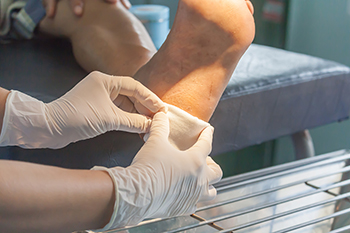Items filtered by date: June 2024
Diagnosis and Symptoms of Foot Puncture Wounds

Foot puncture wounds are injuries where a sharp object pierces the skin and underlying tissues of the foot. These wounds can occur from stepping on nails, glass, or other sharp objects. Proper diagnosis involves a physical examination by a podiatrist, often accompanied by imaging tests like X-rays to assess the depth and presence of foreign objects. Symptoms of a foot puncture wound include pain, swelling, redness, and bleeding at the site of injury. If the wound becomes infected, additional symptoms such as warmth, pus, and increased pain may develop. Timely medical attention is vital to clean the wound thoroughly, prevent infection, and ensure proper healing. If you have stepped on a sharp object and have developed a foot wound, it is suggested that you seek prompt medical treatment from a podiatrist who can effectively manage this condition.
Wound care is an important part in dealing with diabetes. If you have diabetes and a foot wound or would like more information about wound care for diabetics, consult with Steven Wolfington, DPM from Sheboygan Foot Care, LLC. Our podiatrist will assess your condition and provide you with quality foot and ankle treatment.
What Is Wound Care?
Wound care is the practice of taking proper care of a wound. This can range from the smallest to the largest of wounds. While everyone can benefit from proper wound care, it is much more important for diabetics. Diabetics often suffer from poor blood circulation which causes wounds to heal much slower than they would in a non-diabetic.
What Is the Importance of Wound Care?
While it may not seem apparent with small ulcers on the foot, for diabetics, any size ulcer can become infected. Diabetics often also suffer from neuropathy, or nerve loss. This means they might not even feel when they have an ulcer on their foot. If the wound becomes severely infected, amputation may be necessary. Therefore, it is of the upmost importance to properly care for any and all foot wounds.
How to Care for Wounds
The best way to care for foot wounds is to prevent them. For diabetics, this means daily inspections of the feet for any signs of abnormalities or ulcers. It is also recommended to see a podiatrist several times a year for a foot inspection. If you do have an ulcer, run the wound under water to clear dirt from the wound; then apply antibiotic ointment to the wound and cover with a bandage. Bandages should be changed daily and keeping pressure off the wound is smart. It is advised to see a podiatrist, who can keep an eye on it.
If you have any questions, please feel free to contact our office located in Sheboygan, WI . We offer the newest diagnostic and treatment technologies for all your foot care needs.
Life Quality With Heel Pain
 Plantar fasciitis significantly impacts quality of life, primarily due to persistent heel pain. This condition involves inflammation of the plantar fascia, a thick band of tissue running along the bottom of the foot, often resulting in stabbing pain, particularly during the first steps in the morning or after periods of inactivity. The pain can range from a dull ache to sharp discomfort, making walking, standing, and engaging in daily activities challenging. Symptoms can include heel pain, stiffness, and swelling. Common causes are overuse, wearing improper footwear, obesity, and excessive standing or walking on hard surfaces. Relief options include rest, stretching exercises, proper footwear, and orthotic devices to provide arch support. In severe cases, medical interventions such as corticosteroid injections or surgery might be necessary. If you suffer from plantar fasciitis, it is suggested that you schedule an appointment with a podiatrist to manage it and prevent further complications.
Plantar fasciitis significantly impacts quality of life, primarily due to persistent heel pain. This condition involves inflammation of the plantar fascia, a thick band of tissue running along the bottom of the foot, often resulting in stabbing pain, particularly during the first steps in the morning or after periods of inactivity. The pain can range from a dull ache to sharp discomfort, making walking, standing, and engaging in daily activities challenging. Symptoms can include heel pain, stiffness, and swelling. Common causes are overuse, wearing improper footwear, obesity, and excessive standing or walking on hard surfaces. Relief options include rest, stretching exercises, proper footwear, and orthotic devices to provide arch support. In severe cases, medical interventions such as corticosteroid injections or surgery might be necessary. If you suffer from plantar fasciitis, it is suggested that you schedule an appointment with a podiatrist to manage it and prevent further complications.
Plantar fasciitis is a common foot condition that is often caused by a strain injury. If you are experiencing heel pain or symptoms of plantar fasciitis, contact Steven Wolfington, DPM from Sheboygan Foot Care, LLC. Our podiatrist can provide the care you need to keep you pain-free and on your feet.
What Is Plantar Fasciitis?
Plantar fasciitis is one of the most common causes of heel pain. The plantar fascia is a ligament that connects your heel to the front of your foot. When this ligament becomes inflamed, plantar fasciitis is the result. If you have plantar fasciitis you will have a stabbing pain that usually occurs with your first steps in the morning. As the day progresses and you walk around more, this pain will start to disappear, but it will return after long periods of standing or sitting.
What Causes Plantar Fasciitis?
- Excessive running
- Having high arches in your feet
- Other foot issues such as flat feet
- Pregnancy (due to the sudden weight gain)
- Being on your feet very often
There are some risk factors that may make you more likely to develop plantar fasciitis compared to others. The condition most commonly affects adults between the ages of 40 and 60. It also tends to affect people who are obese because the extra pounds result in extra stress being placed on the plantar fascia.
Prevention
- Take good care of your feet – Wear shoes that have good arch support and heel cushioning.
- Maintain a healthy weight
- If you are a runner, alternate running with other sports that won’t cause heel pain
There are a variety of treatment options available for plantar fasciitis along with the pain that accompanies it. Additionally, physical therapy is a very important component in the treatment process. It is important that you meet with your podiatrist to determine which treatment option is best for you.
If you have any questions, please feel free to contact our office located in Sheboygan, WI . We offer the newest diagnostic and treatment technologies for all your foot care needs.
Stretches Can Help to Avoid Running Injuries

Incorporating targeted stretches and strengthening routines into your running regimen is a good way to maintain foot health and prevent injuries. Toe stretches involve gently pulling your toes back to stretch the muscles and ligaments along the sole of your foot and toes, promoting flexibility and reducing the risk of strains or cramps during runs. Plantar fascia stretching entails leaning forward to stretch the arch of your foot, to alleviate tension in the plantar fascia, which is a common source of heel pain in runners. Ankle alphabet exercises promote mobility and range of motion in the ankle joint by tracing the alphabet with your toes, helping to reduce the risk of ankle sprains or strains. The marble pickup exercise enhances the intrinsic muscles of the foot, improving their strength and coordination to prevent common running injuries such as metatarsalgia or Morton's neuroma. Incorporating these and other exercises into your routine strengthens your feet, reduces the risk of running-related injuries, and allows you to enjoy your runs with confidence and longevity. If you are experiencing persistent discomfort or have concerns about your foot health, it is suggested that you schedule an appointment with a podiatrist.
All runners should take extra precaution when trying to avoid injury. If you have any concerns about your feet, contact Steven Wolfington, DPM of Sheboygan Foot Care, LLC. Our podiatrist will treat your foot and ankle needs.
How to Prevent Running Injuries
There are a lot of mistakes a runner can make prior to a workout that can induce injury. A lot of athletes tend to overstretch before running, instead of saving those workouts for a post-run routine. Deep lunges and hand-to-toe hamstring pulls should be performed after a workout instead of during a warmup. Another common mistake is jumping into an intense routine before your body is physically prepared for it. You should try to ease your way into long-distance running instead of forcing yourself to rush into it.
More Tips for Preventing Injury
- Incorporate Strength Training into Workouts - This will help improve the body’s overall athleticism
- Improve and Maintain Your Flexibility – Stretching everyday will help improve overall performance
- “Warm Up” Before Running and “Cool Down” Afterward – A warm up of 5-10 minutes helps get rid of lactic acid in the muscles and prevents delayed muscle soreness
- Cross-Training is Crucial
- Wear Proper Running Shoes
- Have a Formal Gait Analysis – Poor biomechanics can easily cause injury
If you have any questions, please feel free to contact our office located in Sheboygan, WI . We offer the newest diagnostic and treatment technologies for all your foot care needs.
Safeguarding Diabetic Limbs

Preventing amputation of diabetic limbs is essential in preserving mobility and enhancing the quality of life for individuals with diabetes. Regular foot care plays a pivotal role in this endeavor. Daily inspection of the feet for cuts, blisters, or ulcers, along with proper hygiene and moisturization, helps detect issues early and prevent complications. Choosing appropriate footwear that fits well and provides adequate support reduces the risk of pressure points and injuries. Managing blood sugar levels through diet, exercise, and medication adherence is critical in preventing nerve damage and promoting wound healing. Seeking prompt medical attention for any foot problems, no matter how minor, is essential to prevent them from escalating into more serious issues. Regular check-ups with podiatrists allow for comprehensive monitoring of foot health and early intervention if problems arise. If you have diabetes, it is strongly suggested that you are under the care of a podiatrist who can discuss important measures for limb protection.
Diabetic Limb Salvage
Diabetic limb salvage can be an effective way in preventing the need for limb amputation. If you have a foot ulcer and diabetes, consult with Steven Wolfington, DPM from Sheboygan Foot Care, LLC. Our podiatrist will assess your condition and provide you with quality foot and ankle treatment.
What Is Diabetic Limb Salvage?
Diabetic limb salvage is the attempt of saving a limb, such as the foot, that has an infected ulcer, from amputation. Podiatrists also try to make sure that there is enough function in the foot after the salvage that it is still usable. Those with diabetes experience poor blood circulation, which prevents proper healing of an ulcer. If the ulcer is left uncheck, it could become infected, which could result in the need for amputation.
Diabetes is the number one cause of non-traumatic amputations in the United States. Amputation has been found to lead to higher mortality rates. This translates into higher healthcare costs, and a reduced quality of life and mobility for amputees. Podiatrists have attempted to increase the prevalence of limb salvage in an attempt to solve these issues.
Diagnosis and Treatment
Limb salvage teams have grown in recent years that utilize a number of different treatments to save the infected limb. This includes podiatrists that specialize in wound care, rehabilitation, orthotics, and surgery. Through a combination of these methods, limb salvage has been found to be an effective treatment for infected limbs, and as an alternative to amputation. Podiatrists will first evaluate the potential for limb salvage and determine if the limb can be saved or must be amputated.
If you have any questions, please feel free to contact our office located in Sheboygan, WI . We offer the newest diagnostic and treatment technologies for all your foot care needs.

